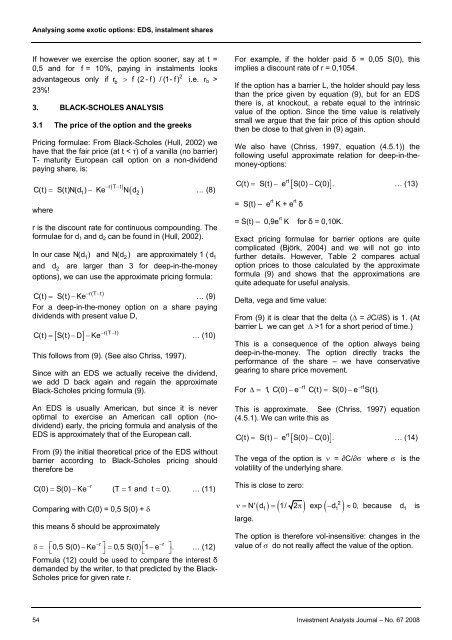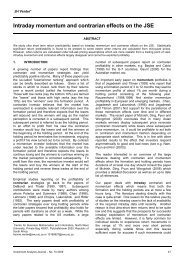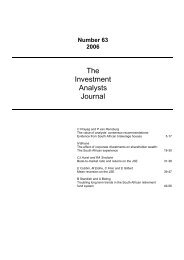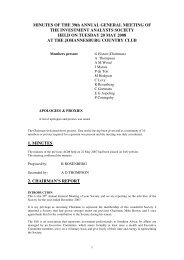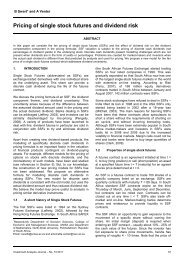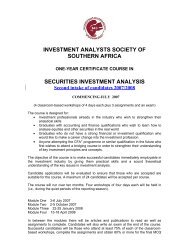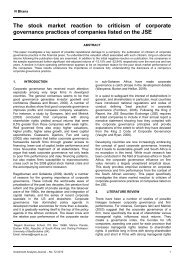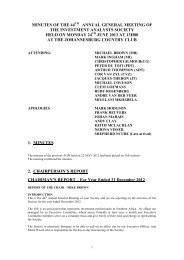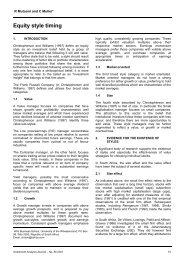Analysing some exotic options - Investment Analysts Journal
Analysing some exotic options - Investment Analysts Journal
Analysing some exotic options - Investment Analysts Journal
Create successful ePaper yourself
Turn your PDF publications into a flip-book with our unique Google optimized e-Paper software.
<strong>Analysing</strong> <strong>some</strong> <strong>exotic</strong> <strong>options</strong>: EDS, instalment shares<br />
If however we exercise the option sooner, say at t =<br />
0,5 and for f = 10%, paying in instalments looks<br />
2<br />
advantageous only if r b > f (2 - f) / (1- f) i.e. r b ><br />
23%!<br />
3. BLACK-SCHOLES ANALYSIS<br />
3.1 The price of the option and the greeks<br />
Pricing formulae: From Black-Scholes (Hull, 2002) we<br />
have that the fair price (at t < τ) of a vanilla (no barrier)<br />
T- maturity European call option on a non-dividend<br />
paying share, is:<br />
−rT ( −t<br />
C(t) = S(t)N(d ) − Ke<br />
)<br />
N d … (8)<br />
where<br />
( )<br />
1 2<br />
r is the discount rate for continuous compounding. The<br />
formulae for d 1 and d 2 can be found in (Hull, 2002).<br />
In our case N(d 1) and N(d 2 ) are approximately 1 ( d 1<br />
and d 2 are larger than 3 for deep-in-the-money<br />
<strong>options</strong>), we can use the approximate pricing formula:<br />
−r(T−t)<br />
C(t) = S(t) −Ke … (9)<br />
For a deep-in-the-money option on a share paying<br />
dividends with present value D,<br />
[ ]<br />
− −<br />
r(T t)<br />
C(t) = S(t) −D −Ke … (10)<br />
This follows from (9). (See also Chriss, 1997).<br />
Since with an EDS we actually receive the dividend,<br />
we add D back again and regain the approximate<br />
Black-Scholes pricing formula (9).<br />
An EDS is usually American, but since it is never<br />
optimal to exercise an American call option (nodividend)<br />
early, the pricing formula and analysis of the<br />
EDS is approximately that of the European call.<br />
From (9) the initial theoretical price of the EDS without<br />
barrier according to Black-Scholes pricing should<br />
therefore be<br />
−r<br />
C(0) = S(0) − Ke (T = 1 and t = 0). … (11)<br />
Comparing with C(0) = 0,5 S(0) + δ<br />
this means δ should be approximately<br />
⎡<br />
−r⎤ ⎡<br />
−r<br />
⎤<br />
δ=<br />
⎣<br />
0,5 S(0) − Ke<br />
⎦<br />
= 0,5 S(0)<br />
⎣<br />
1−e ⎦<br />
. … (12)<br />
Formula (12) could be used to compare the interest δ<br />
demanded by the writer, to that predicted by the Black-<br />
Scholes price for given rate r.<br />
For example, if the holder paid δ = 0,05 S(0), this<br />
implies a discount rate of r = 0,1054.<br />
If the option has a barrier L, the holder should pay less<br />
than the price given by equation (9), but for an EDS<br />
there is, at knockout, a rebate equal to the intrinsic<br />
value of the option. Since the time value is relatively<br />
small we argue that the fair price of this option should<br />
then be close to that given in (9) again.<br />
We also have (Chriss, 1997, equation (4.5.1)) the<br />
following useful approximate relation for deep-in-themoney-<strong>options</strong>:<br />
rt<br />
[ ]<br />
C(t) = S(t) − e S(0) −C(0) . … (13)<br />
= S(t) – e rt K + e rt δ<br />
= S(t) – 0,9e rt K for δ = 0,10K.<br />
Exact pricing formulae for barrier <strong>options</strong> are quite<br />
complicated (Björk, 2004) and we will not go into<br />
further details. However, Table 2 compares actual<br />
option prices to those calculated by the approximate<br />
formula (9) and shows that the approximations are<br />
quite adequate for useful analysis.<br />
Delta, vega and time value:<br />
From (9) it is clear that the delta (∆ = ∂C/∂S) is 1. (At<br />
barrier L we can get ∆ >1 for a short period of time.)<br />
This is a consequence of the option always being<br />
deep-in-the-money. The option directly tracks the<br />
performance of the share – we have conservative<br />
gearing to share price movement.<br />
For<br />
−rt<br />
−rt<br />
Δ= 1, C(0) − e C(t) = S(0) −e S(t).<br />
This is approximate. See (Chriss, 1997) equation<br />
(4.5.1). We can write this as<br />
rt<br />
[ ]<br />
C(t) = S(t) − e S(0) −C(0) . … (14)<br />
The vega of the option is ν = ∂C/∂σ where σ is the<br />
volatility of the underlying share.<br />
This is close to zero:<br />
2<br />
( 1) ( ) ( 1 )<br />
ν= N' d = 1/ 2 π exp −d ≈0, because d 1 is<br />
large.<br />
The option is therefore vol-insensitive: changes in the<br />
value of σ do not really affect the value of the option.<br />
54 <strong>Investment</strong> <strong>Analysts</strong> <strong>Journal</strong> – No. 67 2008


